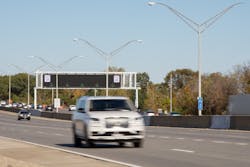Ohio DOT SmartLane congestion relief project migrated to the cloud
Q-Free, a mobility solutions provider for smart city infrastructure, announced its I-670 SmartLane congestion relief project in Columbus, Ohio was successfully migrated to the cloud.
Completed through a partnership with Amazon Web Services (AWS), the Ohio DOT (ODOT) project marks one of the first projects of its kind to move to a cloud-hosted environment. Q-Free says transitioning from an on-site server to AWS will help ensure that the I-670 SmartLane system is always online and functioning.
AWS’s involvement is expected to continue and grow the early success of the six-month-old effort. Early data already show that commute times from downtown Columbus to the east side of the city have been cut in half.
The SmartLane Pilot on I-670 uses Q-Free’s Open TMS advanced traffic management system to provide operators with weather, speed, radar, and camera data to help manage shoulder lanes and relieve congestion. Q-Free says the strategy, called hard shoulder running (HSR) is extensively used throughout Europe but is relatively new to the U.S.
The project originated when ODOT approached Q-Free to address a daily afternoon backup on I-670, as commuters head out of Columbus to the surrounding suburbs.
Q-Free says their algorithm provides a level of artificial intelligence but the decision to open or close the shoulder is squarely in the hands of operations staff. Opening a lane by using HSR gives the roadway about 20-25% more capacity and initial data suggest a dramatic reduction in congestion and commute times.
The solution is pushing out data to traveler information systems and vehicles equipped with smart technology to give citizens more decision-making information, but it will not stop with Columbus. ODOT is also using this technology to manage traffic in snowstorm whiteout conditions along 30 miles of I-90 on Lake Erie.
-------
SOURCE: Q-Free
